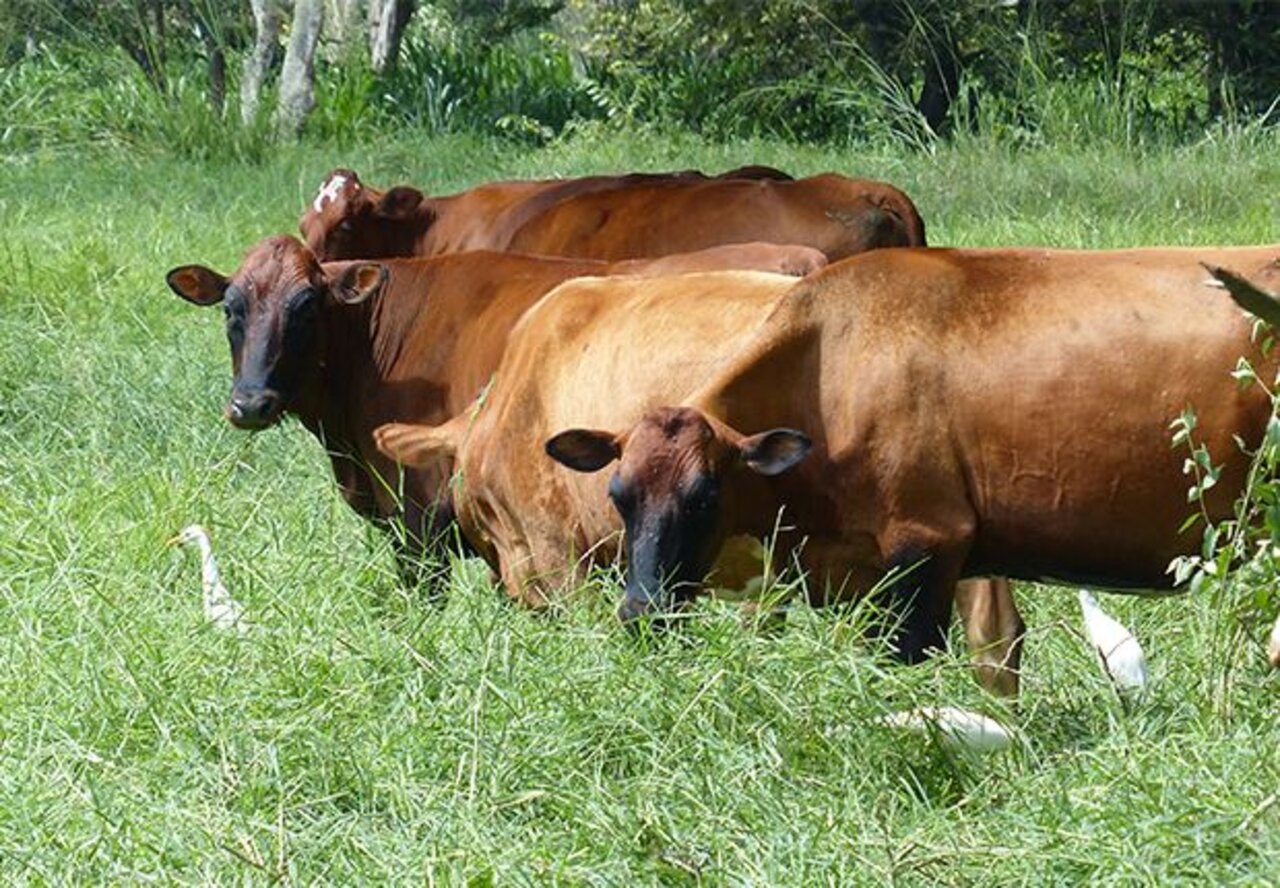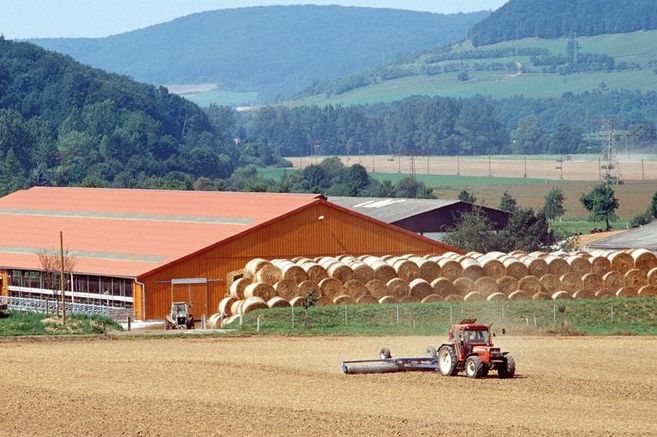Project
GHG mitigation in cattle farming - how much is possible where?

The potential and costs of greenhouse gas mitigation in cattle farming - comparative international analyses of different production systems
Cattle farming for meat production is an important global cause of greenhouse gases in agriculture. However, sources, reduction potential and associated costs vary considerably. We compare across countries.
Background and Objective
11 percent of global greenhouse gas (GHG) emissions are attributed to the agricultural sector. 75 percent of this is accounted for by the production of animal products, with cattle farming accounting for a good two-thirds. In cattle farming, beef production accounts for just under three-fourths worldwide - which amounts to approximately 4 percent of global GHG emissions (FAO, 2018). Within the agricultural sector, however, cattle farming is also considered to be of particular importance in terms of GHG mitigation.
Production systems in cattle farming differ worldwide, in some cases significantly, in terms of factor input, animal productivity, production costs and GHG emission profile. The production environment also shows some significant differences, e.g. with regard to the availability of resources and infrastructure, climatic conditions or the cultural significance of animal husbandry. Based on the diversity of production conditions, mitigation strategies must be adapted to regional circumstances. The basic hypothesis for this research project is that, given the above, there are significant differences in reduction potentials and costs.
Climate protection and GHG reduction are a global challenge. For an effective climate protection policy, analyses based on comparable data sets are necessary. Within the framework of the project, a concept for the harmonised evaluation of GHG mitigation strategies will be developed, which allows comparisons to be made with regard to costs and potential across production systems and countries.
Approach
Production-related GHG emissions are quantified on the basis of typical production systems in the agri benchmark Beef network. In selected countries (e.g. Brazil, Canada, Germany), locally adapted reduction strategies are identified, specified and their effects quantified as part of calculations for the typical farms. The results are analysed with regard to their potential and costs. In addition, possible adoption barriers will be identified. The reduction scenarios are examined for their acceptance and probability of implementation. The results of the GHG reduction strategies will also be discussed with regard to possible side effects (e.g. rebound or leakage effects).
Data and Methods
The basis for the comparative analysis of typical production systems is the Standard Operating Procedure (Deblitz, 2018) used in the agri benchmark network Beef. In focus groups with producers, consultants and local production economists, we collect data on production systems (animal numbers, categories, performance data, feed rations, etc.) and on prices and costs of typical cattle farming systems. For this baseline the economic viability and GHG emissions are calculated. The calculation of production-related GHG emissions is based on internationally recognised methods (IPCC, 2019 refinements). The reduction strategies are determined on the basis of local research results and focus groups. For this purpose, the individual production and accounting model TIPI-CAL is applied. The economic analysis is extended by questioning cattle farmers about their willingness to implement reduction measures.
Our Research Questions
- What are the greenhouse gas profiles of typical cattle production systems in different production regions?
- Which greenhouse gas reduction strategies can be applied in the different production systems and regions and what are the associated reduction potential and costs?
- What are the barriers to the implementation of reduction strategies and how high is the probability of adoption in this context?
- What are the potential side effects of mitigation strategies and how relevant are their climate impacts?
Preliminary Results
Project results are available via the linked publications.
Thünen-Contact

Involved Thünen-Partners
Duration
3.2018 - 8.2026
More Information
Project status:
ongoing
Publications to the project
- 0
Lassen B, Fuchs B (2024) "Wir müssen die CO2-Rechner vereinheitlichen" [Interview]. DLG Mitt(10):29
- 1
Agethen K, Mauricio RM, Deblitz C, Izquierdo MD, Reyes E, Chará J (2024) Future perspectives of Brazilian beef production: what is the role of Silvopastoral systems? Agrofor Syst 98(7):2179-2196, DOI:10.1007/s10457-024-01005-7
- 2
Agethen K, Mauricio RM, Deblitz C, Pacheco A, Cangussú M, Chará J, Reyes E (2023) Future perspectives of Brazilian beef production? Economic and environmental analysis of three beef production systems in Brazil. In: Rivera J, Viñoles C, Fedrigo J, Bussoni A, Peri P, Colcombet L, Murgueitio E, Quadrelli A, Chará J (eds) Sistemas Silvopastoriles : Hacia una diversificación sostenible ; XII Congreso Internacional de Sistemas Silvopastoriles, II Congreso de la Red Global de Sistemas Silvopastoriles, IV Seminario Seminario Nacional de Sistemas Silvopastoriles, Montevideo, Uruguay, V Congreso Nacional Sistemas Silvopastoriles, Buenos Aires, Argentina. Cali, Colombia: CIPAV, pp 941-953
- 3
Lassen B, Danne M, Gentz M (2023) Gut geschätzt ist halb gemessen. Allgäuer Bauernbl 91(18):23-25
- 4
Agethen K, Lassen B (2023) Wo Verbesserungen ansetzen können : die Treibhausgasemissionen in der Wertschöpfungskette der Milch - Herausforderungen und Anknüpfungspunkte. Dt Molkerei Zeitg 144(6):22-23
- 5
Agethen K, Lassen B (2022) Treibhausgasemissionen in der Wertschöpfungskette Milch : Herausforderungen und Anknüpfungspunkte. In: Aktuelle Entwicklungen zur Reduktion des Umwelteinflusses in der Milchwirtschaft : Kompendium 20. Ahlemer Fachtagung 2022. Bad Breisig: B&L MedienGesellschaft, pp 12-13
- 6
Agethen K, Mauricio RM, Deblitz C (2021) Economics of greenhouse gas mitigation strategies in a north-eastern Brazilian beef production system [online]. In: International Grassland Congress <24, 2021, Online> (ed) International Grassland Congress proceedings : XXIV International Grassland Congress / XI International Rangeland Congress. Nairobi, Kenya: KALRO, zu finden in <https://uknowledge.uky.edu/igc/24/3-2/3/> [zitiert am 03.11.2022]








